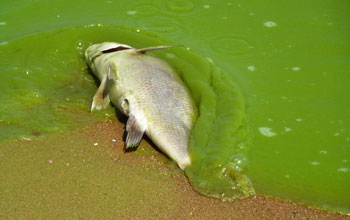Algal toxins are toxic substances released by some types of algae when they are present in large quantities (Blooms) and decay or degrade. These toxins are called ‘Phycotoxins’ (from Greek, phykos, “seaweed”; and toxikon, “toxin”). They are usually complex allelopathic metabolites produced by algal secondary metabolic pathways. These metabolites are (in most cases) not harmful to the producer but may be toxic to either one or many members of the marine food web.
Good to know
- Of the more than 50 genera of blue green algae at least 8 have exhibited toxic characteristics of these include Anabaena sp., Aphanizomenon sp., Coelosphaerium sp., Gleotrichia sp., Lyngbea sp., Nodularia sp., and Nostoc sp. (Mike Collins, 1978). The incidents of toxicity of these blue green algae have been reported by Schwimmer and Schwimmer 1964; 1968).
- Pyrrophyta or fire algae is a division of unicellular algae that has a yellow brown color, and has two different flagella which are ribbon-shaped. It contains some pigments (chlorophyll-a, chlorophyll-b, c1, c2 and fucoxanthin) that can photosynthesize.
Early botanists classified dinoflagellates as a separate division of algae, which they named Pyrrophyta, after the Greek word ‘pyrr(h)os’ meaning fire. Later it was found that Pyrrophyta division includes many members which for the convenience of study were divided into dinoflagellates and cryptomonads.
- Dinoflagellates: Have cell walls.
- Cryptomonads: Do not have cell walls, contain proteinaceous plates.
Blooms
A heavy growth of algae causing a distinct color to a body of water is called bloom. It is a rapid increase in the population of algae in an aquatic system. Algal blooms may occur in freshwater as well as marine environments.
- Blooms occur primarily in tropical and subtropical regions of the world having eutrophic waters.
- In water bodies of tropical, subtropical and Polar region, blooms are found mostly in spring and summer where as in the temperate region it occurs in Spring and Fall seasons.
Bloom forming factors
Algal blooms are induced by eutrophication i. e an overabundance of nutrients in the water. The two most common nutrients are fixed nitrogen (nitrates, ammonia, urea) and phosphate. These nutrients are usually emitted by agriculture, other industries, excessive fertilizer use in urban/suburban areas and associated urban runoff. Higher water temperature and low circulation are contributing factors.
Common algal blooms
- Blue green blooms: Microcystis aeruginosa, Anabaena flos-aquae, etc.
- Green blooms: Chlorella, Chlamydomonas, Scenedesmus, etc.
‘Red-tide’: Mostly by dinoflagellates like Gonyaulux catenella, Gymnodinium brevis, Protogonyaulux, Noctiluca milliaris, Prorocentrum, etc. and Raphidophytes or chloromonads such as Chattonella antigua),
- Red tides primarily occur in tropical and subtropical coastal waters where the algal concentration ranges from 1-20 million cells/litre.
- The red color of the Red sea is caused by Trichodesmium erythraeum.
Blooms may occur on snow (cryogenic) and may be called “red snow’ (Chlamydomonas nivalis, species of Scotiella, species of Hormidium, Ulothrix flacida, Chlorella, etc) which may be green in relatively low light environment or early stage of bloom, black snow (species of Raphidionema) and purple-brown snow (Ancyclonema nordenskioldii).
Blooms impact on aquatic biota and human being
Algal bloom can be harmful to aquatic lives and human
(a) directly
(b) by producing toxin
By producing toxin
The chemical nature and mode of action by various types of toxins produced by algal organisms are given below:
The toxins are of three types:
Best safe and secure cloud storage with password protection
Get Envato Elements, Prime Video, Hotstar and Netflix For Free
Best Money Earning Website 100$ Day
#1 Top ranking article submission website
- Those that primarily kill fish and a few invertebrates (Gymnodinium)
- Those that primarily kill invertebrates (Gonyaulux)
- Those that don’t kill fish or invertebrates but produce toxins and are concentrated by filter feeding bivalves and shellfish (Protogonyaulux).
Impact on fishes
Large growth of microalgae clogs gills which in turn affect the transfer of oxygen to gill lamellae of fish causing respiratory failure leading to fish killing. The water body becomes anoxic (extreme low oxygen) due to rapid uptake of oxygen in water and atmospheric oxygen can’t diffuse into the water resulting suffocation and subsequent death of fishes and other biota.
Impact on recreation
In another way, the microalgae die and decompose, produce obnoxious smell in the surroundings. This affects recreational areas and the water becomes unusable for swimming, bathing, boating, & for other purposes. Sometimes, bathing in blooming aquatic bodies cause itching of skin.
Impact on non-target animals
Several groups of microalgae produce toxins that sicken and kill other organisms (grazers and nontarget organisms like domestic animals, birds, human, etc.).
Impact on human via filter feeding organisms
Filter feeding organisms like shellfish can accumulate large quantities of these toxins without any effect on it. But consumption of these fishes by man, birds, and animals results in sickness and death.
The toxins are neurotoxins and cause paralytic shellfish poisoning. The toxins usually are accumulated in the shellfish, which if eaten will result poisoning.
The illness include vomiting, diarrhoea. Sometimes neurological (memory loss, disorientation) amnesia occurs due to shellfish poisoning by Pseudo-nitzschia, a diatom causing all of the above symptoms. Even death by “domoic acid”, a derivative of the neuroexcitatory amino acid L-glutamic acid might occur due to this algae .
- The domoic acid is produced due to silicate and phosphate deprivation.
Toxins & death factors
The history of algal toxicity is at least thousand years old. The earliest reports of Cyanobacteria poisoning may have been around 1,000 years ago when general Zlu-Ge-Ling reported mortalities in troops that drank water from a river in southern China. But first known incidents of Cyanobacteria toxin poisoning was from an Australian lake in 1878 (Chorus and Bartram,1999, Francis, 1878).
Hepatoxins (hepa means liver): Hepatoxins is a group of toxins that include Microcystin, Nodularin, Okadaic acid (poly-ether carboxylic acid) and Yessotoxin. They usually attack the liver.
- Okadaic acid (poly-ether carboxylic acid) and Yessotoxin are hepatoxins from dinoflagellates (Protoceratium). It causes diarrhetic shellfish poisoning, a severe gastroenteritis.
- Microcystin (Microcystis, Anabaena) and nodularin (Nodularia) are hepatotoxins (peptide derivative) causing bleeding in the liver.
The name microcystis derived from the toxins that were first isolated from Microcystis aeruginosa. The toxicity of microcystin is due to their strong binding to protein phosphatases (Chorus and Bartram 1999).
- Anabaenaflos-aquae produce “very first death factor” (death within 1-10 min.) called microcystin.
- Microcystis aeruginosa produce “ first death factor” (death within 1-2 hours) called microcystin.
Anatoxin & Saxitoxin: Anatoxin and saxition are alkaloids (nitrogen containing compounds) produced by cyanobacteria. They block the transmission of signal from neuron to neuron and neuron to muscle. So they are neurotoxin alkaloids.
Many of the cyanobacteria produce this Anatoxin which is a “slow death factor” (death within 4-48 hours). Examples of such cyanobacteria include Trichodesmium.
Many of the dinoflagellates (Alexamdrium, Pyrodinium bahamense) produce “saxitoxin” whose potency is very high. Saxitoxins are heterocyclic guanidine neurotoxins act like carbamate pesticides. Blooms of these toxic species have led to mass kills of fish, native mammals and live stock as well as the contamination of fresh water resources. (Negri Jones.,GJ et al 1995; Sawyer Gentile., 1968).
Saxitoxin (purine derivatives) causes paralytic shellfish poisoning.
Brevetoxins & Ciguatoxin: Brevetoxins and Ciguatoxin are non-nitrogenous neurotoxins that cause Ciguatera fish poisoning. These are ion-channel disrupters increasing the permeability of positive ions causing membrane depolarization. The depolarized nerves supplying to heart reduces heart rate there by lowering the blood pressure.
Brevetoxins are produced by dinoflagellates (e.g. Gymnodinium sp) and Raphidophytes (Chattonella antigua, Heterosigma carterae).
Anatoxin, saxitoxin, microcystin, nodularin are called Cyanotoxins as they are produced from BGAs or Cyanobacteria. Usually they are released after the death of algae in their (?) intestine.
References & Other Links
- Harmful Algal Blooms by Wikipedia.
- Algal Toxins & Their Impact on Human Health by Biomedical & Pharmacology Journal.
Revised by
- Abulais Shomrat on 11th June, 2021.
 Plantlet The Blogging Platform of Department of Botany, University of Dhaka
Plantlet The Blogging Platform of Department of Botany, University of Dhaka





